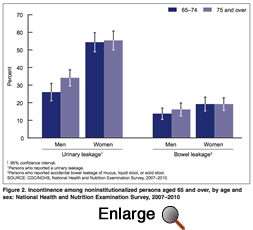 Urinary incontinence (UI) increases with age.
Urinary incontinence (UI) increases with age."Approximately 17 million adults in the US suffer from urinary incontinence. Urinary incontinence is a leading cause of admission to nursing homes, and nearly half of nursing home residents have some degree of incontinence. Women are twice as affected as men. Nearly 35% of female Medicare beneficiaries and 25% of male beneficiaries are estimated to suffer from urinary incontinence" (CMS 2000).
Urinary incontinence affects nearly 40% of all adult American women. More than 25% of teenage and college-aged female athletes experience incontinence with more than 90% withholding incontinence information to their primary care providers. In nursing homes, approximately 6% of admissions are due to urinary incontinence (Harris & Riggs 2021).
Although the prevalence of incontinence increases with age, it is not a normal consequence of aging. Incontinence is often distressing and can be disabling in the elderly. It can have a tremendous effect on the quality of life and other health conditions. Nearly a third of all patients do not speak to their doctor about incontinence, thereby increasing morbidity"(CMS 2000).
 Urinary incontinence (UI) increases with age.
Urinary incontinence (UI) increases with age.
Sier, Ouslander and Orzeck (1987), reported 35% of geriatric patients in an acute-care hospital setting experienced incontinence at some time during their stay. These researchers also found that:
Instant Feedback:
Incontinence is common but is not a normal consequence of aging.
Centers for Medicare & Medicaid Services (CMS 2000).
Decision Memo for Pelvic Floor Electrical Stimulation for Urinary Incontinence (CAG-00021N)
http://cms.gov/medicare-coverage-database/details/nca-decision-memo.aspx?NCAId=61
Harris S, Riggs J. Mixed Urinary Incontinence. [Updated 2021 Jul 19]. In: StatPearls [Internet]. Treasure Island (FL): StatPearls Publishing; Available from: https://www.ncbi.nlm.nih.gov/books/NBK534234/"
Landefeld, C. S. (2008). National Institutes of Health State-of-the-science conference statement: Prevention of fecal and urinary incontinence in adults. Annals of Internal Medicine, 148(6), 449. https://doi.org/10.7326/0003-4819-148-6-200803180-00210
Milsom, I., & Gyhagen, M. (2019). The prevalence of urinary incontinence. Climacteric : the journal of the International Menopause Society, 22(3), 217–222. https://doi.org/10.1080/13697137.2018.1543263
Sier, H; Ouslander,J; Orzeck, S. (1987) Urinary Incontinence Among Geriatric Patients in an Acute-Care Hospital. JAMA. 1987;257(13):1767-1771
© RnCeus.com